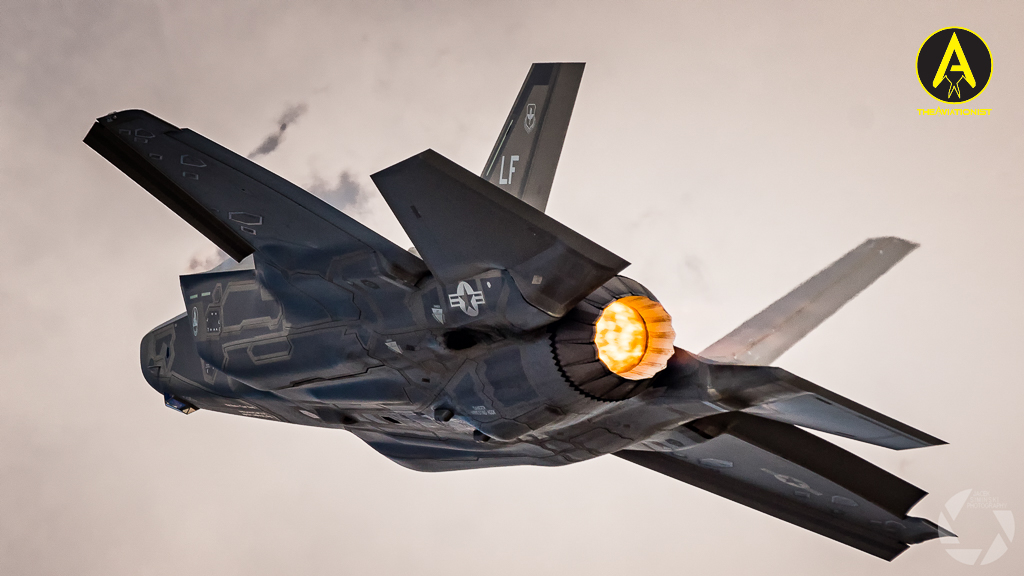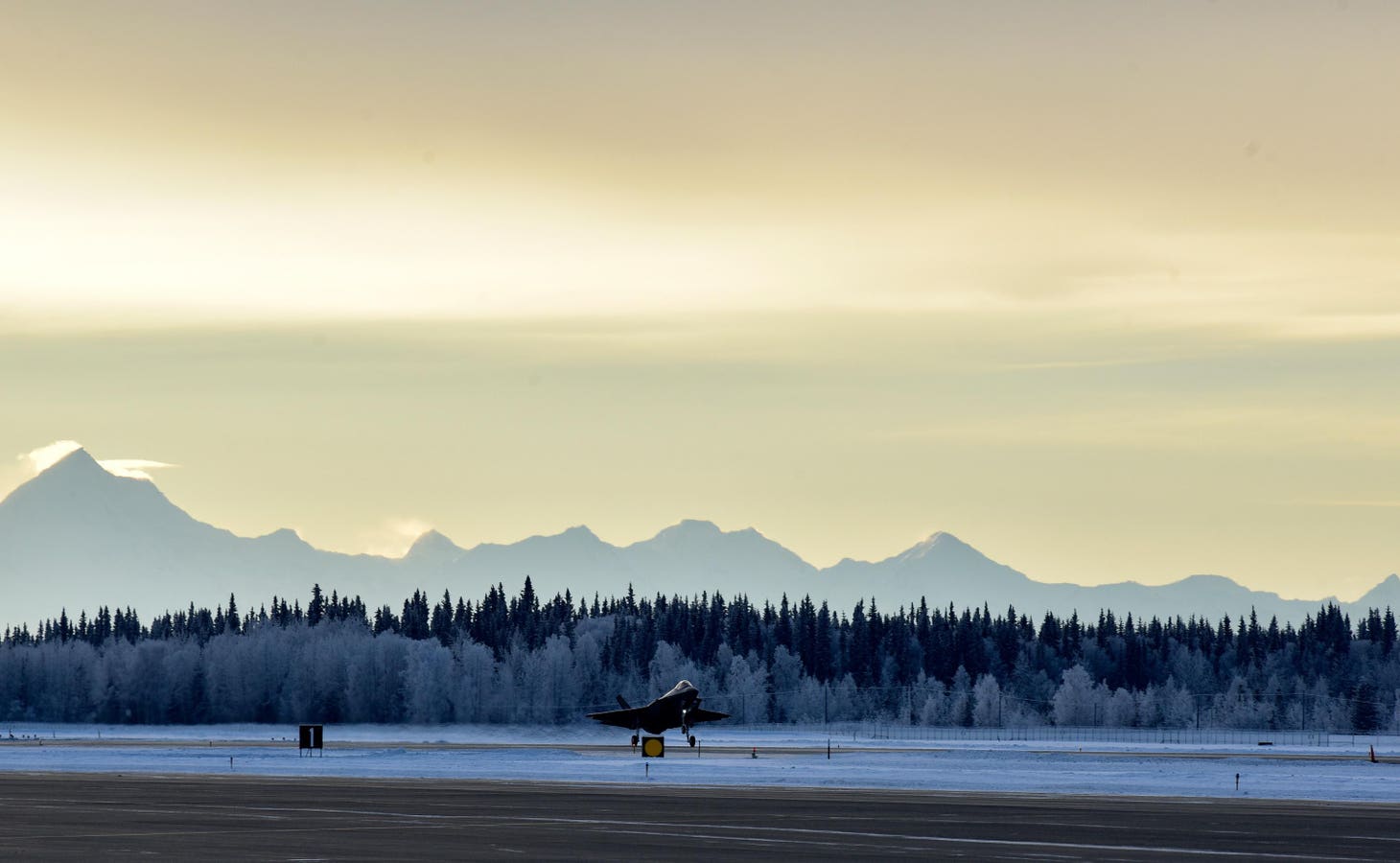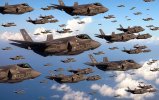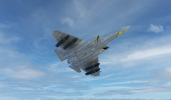Tällainen siistimpi kuva, josta laskin yhteensä n. 120 F-35:a. Eli tuolta näyttää karkeasti yhdessä kuvassa pumppu, joka olisi noin tuplasti meidän tulevaa fleetiä isompi. Tai suurin piirtein tuolta näyttäisi koko Britannian alun perin kaavailema 138 F-35:n pumppu taivaalla.
Install the app
How to install the app on iOS
Follow along with the video below to see how to install our site as a web app on your home screen.
Note: This feature may not be available in some browsers.
You are using an out of date browser. It may not display this or other websites correctly.
You should upgrade or use an alternative browser.
You should upgrade or use an alternative browser.
F-35 Lightning II
- Viestiketjun aloittaja Hejsan
- Aloitus PVM
Olympiakasarmi
Kenraali

Full weapons tester report highlights F-35 availability, software problems
"The F-35 did not suddenly become a more reliable aircraft in 2021,” Dan Grazier of the Project on Government Oversight wrote. “It takes extraordinary effort to keep the fleet operating even close to the required levels."

Kongsberg: Norway’s F135 Engine Heavy Maintenance Facility Achieves Initial Depot Capability - EDR Magazine
March 17th, 2022 – KONGSBERG, acting through its Maintenance, Repair and Overhaul (MRO) company Kongsberg Aviation Maintenance Services AS (KAMS),
Engines - Kongsberg Aviation Maintenance Services
Kyllä olisi ollut vaikeaa Suomeen moottoripajaa näin lähelle toista ajatella jos Patria ei olisi KAMSissa jo 49,9 prossan osuudella.
rty19
Greatest Leader
USA suunnittelee vähentävänsä reilusti F-35-hankintojaan ensi vuonna – Ostaakin F-15-hävittäjiä enemmän
Bloomberg kertoo Yhdysvaltain muuttuneista suunnitelmista F-35- ja F-15-hankintojen suhteen.
Switzerland to receive most F-35s from Italian plant
24 Mar 2022 Gareth Jennings
"Switzerland is to receive the bulk of its Lockheed Martin F-35 Lightning II Joint Strike Fighter (JSF) aircraft from the Italian production plant in Cameri, the Federal Department of Defence, Civil Protection, and Sport (VBS) said on 24 March.
The VBS announced that most of its F-35A aircraft will come from the final assembly and checkout (FACO) facility in Italy, with some coming from the Fort Worth production line in the United States, and perhaps others being built in Switzerland itself as part of an offset package for RUAG...."
24 Mar 2022 Gareth Jennings
"Switzerland is to receive the bulk of its Lockheed Martin F-35 Lightning II Joint Strike Fighter (JSF) aircraft from the Italian production plant in Cameri, the Federal Department of Defence, Civil Protection, and Sport (VBS) said on 24 March.
The VBS announced that most of its F-35A aircraft will come from the final assembly and checkout (FACO) facility in Italy, with some coming from the Fort Worth production line in the United States, and perhaps others being built in Switzerland itself as part of an offset package for RUAG...."
Switzerland to receive most F-35s from Italian plant
Switzerland is to receive the bulk of its Lockheed Martin F-35 Lightning II Joint Strike Fighter (JSF) aircraft from the Italian production plant in Cameri, the Federal...
www.janes.com
Sveitsin analyysia f-16 netissä
Eli tuotantoslotti menee jos eivät allekirjoita maaliskuuhun 2023 mennessä samaa paprua, johon Suomi vetäisi omansa äskettäin.
As elsewhere in Europe, the beginning of the war in Ukraine has started some tectonic plates shifting. The Liberal Radical Party wants defence spending to go up to 1% of GDP instead of 0.7% and pressure has been applied on the anti-F35A committee to withdraw their ballot initiative, which they have refused to do. The armed forces are concerned that the timing of it will make Switzerland lose it's slot, as they have till March next year to do so, and that's the deadline for signing the contract too. I expect more rumblings to happen as things get worse in the East.
View topic - Swiss F-35 Lightning? • F-16.net
Military aviation forum since 2003, with high quality discussion focusing on the F-16, F-35 and F-22 jet fighters and the C-130.
www.f-16.net
Eli tuotantoslotti menee jos eivät allekirjoita maaliskuuhun 2023 mennessä samaa paprua, johon Suomi vetäisi omansa äskettäin.
Huhta
Greatest Leader
Sveitsin analyysia f-16 netissä
View topic - Swiss F-35 Lightning? • F-16.net
Military aviation forum since 2003, with high quality discussion focusing on the F-16, F-35 and F-22 jet fighters and the C-130.www.f-16.net
Eli tuotantoslotti menee jos eivät allekirjoita maaliskuuhun 2023 mennessä samaa paprua, johon Suomi vetäisi omansa äskettäin.
Eikö sitä kansanäänestystä saa aikaistettua?
Kanada valitsi F-35:n:
https://www.cp24.com/news/canada-chooses-to-buy-f-35-fighter-jet-cp-sources-1.5837644
https://www.cp24.com/news/canada-chooses-to-buy-f-35-fighter-jet-cp-sources-1.5837644
Russian President Vladimir Putin is “unquestionably the best F-35 salesman of all time,” said Richard Aboulafia, managing director at AeroDynamic Advisory. The new defense appropriations bill funds 98 Lockheed Martin F-35s, an increase of 20 fighters from the Pentagon's proposal.
One hurdle, facing both the U.S. and European defense industry, is supply chain constraints. For example, the F-35 market “is clearly moving towards [producing] 200 [jets] a year, but [Lockheed Martin has] said, we really can’t do more than 156 for the next few years,” Aboulafia said.

Russia threat sets off mad dash for defense dollars
The “happy days are here again” for weapons manufacturers, one consultant said.
Viimeksi muokattu:
apumekaanikko
Majuri
Quorassa oleva tarina häivepinnoituksista

James Smith
Answered Oct 29, 2021 · Upvoted by
Anthony Hendrex
, former KC-135, T-38 Pilot at U.S. Air Force (1974-1980) · Author has 630 answers and 5M answer views
The F-35’s skin is comprised of 4 layers; the carbon composite bottom layer that provides structural rigidity to the airframe, a new “fibermat” layer which is believed to incorporate the problematic conductive layer of earlier stealth coatings into a layer that’s part of the load-bearing structure (like the composite below it), a primer which is generally just used to help with coating adhesion and corrosion protection (but may have some radar absorbent quality), and then finally a topcoat that provides the jet it’s grey look, provides radar absorption qualities and reduces IR signature.

The image above comes from an unclassified 2017 presentation made by a USAF officer, with the presentation hosted by the National Center For Manufacturing Sciences.
How the layers exactly operate to reduce radar reflections, and what they’re comprised of / how exactly they’re produced is classified.
The F-35 also has radar absorbent elastomer-based seals for panels that need to be frequently accessed or actuated, as well as radar-absorbent tapes used to hide seams / gaps between panels that don’t need to be frequently accessed. The cockpit canopy also has coatings to prevent radar reflecting off the unstealthy cockpit internals, including the pilot. The composition of these canopy coatings and seals / tapes are naturally also classified.

James Smith
Answered Oct 29, 2021 · Upvoted by
Anthony Hendrex
, former KC-135, T-38 Pilot at U.S. Air Force (1974-1980) · Author has 630 answers and 5M answer views
The F-35’s skin is comprised of 4 layers; the carbon composite bottom layer that provides structural rigidity to the airframe, a new “fibermat” layer which is believed to incorporate the problematic conductive layer of earlier stealth coatings into a layer that’s part of the load-bearing structure (like the composite below it), a primer which is generally just used to help with coating adhesion and corrosion protection (but may have some radar absorbent quality), and then finally a topcoat that provides the jet it’s grey look, provides radar absorption qualities and reduces IR signature.
The image above comes from an unclassified 2017 presentation made by a USAF officer, with the presentation hosted by the National Center For Manufacturing Sciences.
How the layers exactly operate to reduce radar reflections, and what they’re comprised of / how exactly they’re produced is classified.
The F-35 also has radar absorbent elastomer-based seals for panels that need to be frequently accessed or actuated, as well as radar-absorbent tapes used to hide seams / gaps between panels that don’t need to be frequently accessed. The cockpit canopy also has coatings to prevent radar reflecting off the unstealthy cockpit internals, including the pilot. The composition of these canopy coatings and seals / tapes are naturally also classified.
Ja Saab jäi jälleen nuolemaan näppejään.
Australia vauhdittaa 2.6 miljardilla JASSM-ER ja JSM toimitusta (/integrointia?).
Katso liite: 59713
 aviationweek.com
aviationweek.com
Katso liite: 59713
Australia Invests Billions To Fast-Track Missile Deliveries | Aviation Week Network
Concerned about the military build-up in the Indo-Pacific and threats against Australia, Canberra is spending A$3.5 billion ($2.6 billion) to accelerate deliveries of two types of missile.

F-35: Capabilities, Missions, Kinematics, Role In Ukrainian Crisis And Beyond. Interview With Billie Flynn
"The F-35 was designed to operate in highly contested airspace, with capabilities precisely focused on what we have been seeing in Ukraine today." We have
Hill AFB’s 388th OSS exploring agile communications options for F-35A
Published March 31, 2022 By Micah Garbarino 388th Fighter Wing Public Affairs
HILL AIR FORCE BASE, Utah (AFNS) --
The 388th Fighter Wing’s Operations Support Squadron cyber Airmen are currently exploring high-speed communications options to support F-35A Lightning II Agile Combat Employment – operating from remote or austere locations.
The flow of information is critical in any war-time environment, and space and cyber capabilities almost completely dominate that arena for modern militaries. Speed and reliability in communications are demanding to support the cyber needs of the F-35's associated systems.
“We’re trying to get after what is Secretary [Frank] Kendall’s fifth operational imperative; ‘Defining optimized resilient basing, sustainment, and communications in a contested environment,’” said Lt. Col. Maxwell Cover, 388th OSS commander. “With the F-35, we are likely going to be using the ACE construct on any deployment, and we need resilient, redundant communications.”
For the first time, cyber Airmen used satellite and cellular internet capabilities to connect an F-35 deployed debrief facility (housing an Autonomic Logistics Information System server stack) and looped back into the Air Force network’s “central point of entry” for F-35 supply chain and logistics.
They did this with the help of cyber teams from Air Combat Command, ACC’s Agile Battle Labs initiative and Combat Communications, who analyze units’ operational needs and help them become more agile in the cyber realm.
“A huge piece of agile combat operations is hardening communications,” Cover said. “These teams are helping us develop better connectivity for the massive amounts of data that we need to push through ALIS.”
Current military satellite internet capability requires a longer lead time, and its fastest speeds are not sufficient for the amount of data required for remote F-35 operations, Cover said.
“If we have to get out the door quickly, that doesn’t work. When you look at operating out of a remote location for days, weeks, maybe longer, where we need ALIS, NIPR, and SIPR, it’s critical to have more agile communications,” Cover said.
Using a Flyaway Communications Terminal developed by the ABL team, the group harnessed speeds up to 30 times faster during the week-long test. It was more than enough to support ALIS as well as individual NIPR and SIPR connections.
The setup requires linking a small satellite-internet dish with a gateway router in a hard-sided case, then to a terminal that splits classified and unclassified data.
The gateway router has the capability to connect to a hardline network, satellite internet, or it also has several slots for cellular sim cards which can transmit data from many bands and regions. The router automatically selects which signal and network is fastest and transmit data simultaneously.
All of this is small enough to fit inside of an F-35’s travel pod, and virtually any Airman can be trained to set it up in less than 10 minutes, said Senior Master Sgt. Reid Beveridge, Agile Battle Labs senior enlisted advisor.
“Really, what we want to have is options for communications,” said 1st Lt. Corbin Meredith, 388th OSS, “We don’t have the infrastructure in every possible location, but with this we could go to SATCOM or cellular LTE and then go to offline capabilities as a last resort. The fact that anyone can be trained to set it up gives us more manpower options and brings another element to creating Multi-Capable Airman.”
Video... lähtee äkäiseen.
A U.S. Air Force F-35A Lightning II fires an AIM-9 missile over the Gulf of Mexico, March 22, 2022. Additional F-35A over the Gulf included.

 www.dvidshub.net
www.dvidshub.net
Members of the 48th Fighter Wing test alert launch capabilities at Ämari Air Base, Estonia, March 2, 2022.
(tässä näkyy käytössä mm. kannettava padi, joka on lentäjällä apuna)

 www.dvidshub.net
www.dvidshub.net
A U.S. Air Force F-35A Lightning II fires an AIM-9 missile over the Gulf of Mexico, March 22, 2022. Additional F-35A over the Gulf included.

WSEP-E 22.06
A U.S. Air Force F-35A Lightning II fires an AIM-9 missile over the Gulf of Mexico, March 22, 2022. Additional F-35A over the Gulf included.
Members of the 48th Fighter Wing test alert launch capabilities at Ämari Air Base, Estonia, March 2, 2022.
(tässä näkyy käytössä mm. kannettava padi, joka on lentäjällä apuna)

48 FW tests alert launch capabilities with F-35 in Estonia
Members of the 48th Fighter Wing test alert launch capabilities at Ämari Air Base, Estonia, March 2, 2022.
The F-35 also has really good acceleration. The engine is a beast. If you start at say, 200 knots, the F-16 and F-35 side-by-side using full afterburners, the F-35 will reach Mach 1 faster. It will also beat an F-22 to Mach 1.


Col. David Berkland, Keeper Of F-35s At Eielson AFB, On Russia, Fear, More
Col. David Berkland oversees 3,000 airmen at Eielson AFB, Alaska. Remote as it seems, the base is strategic for its proximity to Russia. A full 49 F-35s and 18 F-16s reside up there.
 www.forbes.com
www.forbes.com
Einomies1
Respected Leader
Ja F-35 jää vauhdista molemmille mach 1 jälkeen. Suunnittelu on optimoitu tuohon mach 1 tienoille ja ei ole supercruisea.
"Kävelyvauhdista" transoonisen puoliväliin asti on siis aivan pitelemätön.
Col. David Berkland, Keeper Of F-35s At Eielson AFB, On Russia, Fear, More
Col. David Berkland oversees 3,000 airmen at Eielson AFB, Alaska. Remote as it seems, the base is strategic for its proximity to Russia. A full 49 F-35s and 18 F-16s reside up there.www.forbes.com
Tuosta linkistä bongattu toinen mielenkiintoinen juttu:
And because of our strategic location here in Alaska, we can get into the Pacific or Europe or anywhere in the northern hemisphere in a single-fighter sortie, using air-fueling. Billy Mitchell in the 1930s said, “Whoever holds Alaska holds the world.” That remains true today. That’s why we’ve got the F-35s here. The world map is very deceptive. We are closer to Beijing than Hawaii is to Beijing. Alaska is actually further west than Hawaii. We can also take the polar route. Our base is named after Ben Eielson, who was first to fly from North America to Europe over the North Pole.
Eli yllätys, yllätys: pohjolan puolustukseen voi USAF Europen lisäksi pölähtää US- vahvistuksia nopeimmin Alaskasta! Googlemaps ja monet muut kartat näytetään Mercatorin projektiona, joka ei näytä maapalloa realistisesti ja vääristää tiettyjen maiden kokoa (Grönlanti, Australia) lähellä projektion pystyakselin ääripäitä. Se tuppaa unohtumaan monesti.
Esimerkkinä: Lentomatka kalotin ylitse Gulfstreamilla kestää 7 h 34 min Fairbanksista(lähellä Eielsonia) Bodö:n. Matka on 5260 km. Vertailuna Eglin AFB- Bodö matkan kesto samalla speksillä 10 tuntia 35 min ja lentomatka 7351 km.
Täällä voi laskea itse: https://flight-distance.com/
3-D satelliittikuva maapallosta: https://satellitemaps.nesdis.noaa.g...ndex.html?id=ced40646adeb41f1ad60786a23f03edf


